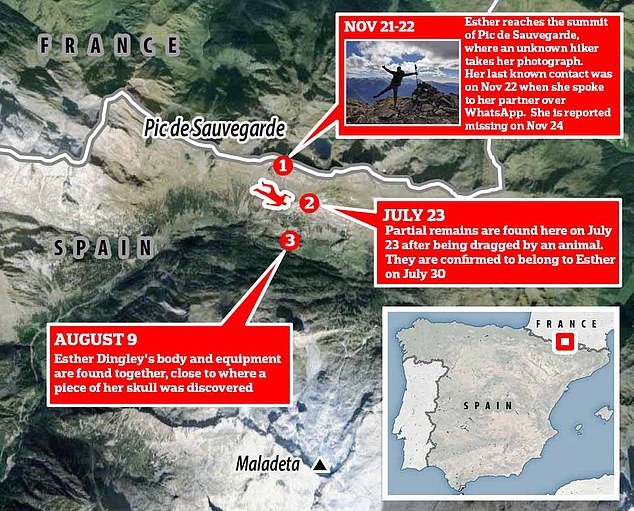Published: 18:59 BST, 11 August 2021 | Updated: 18:59 BST, 11 August 2021
Dan Colegate, 38, uncovered 37-year-old Esther's body on Monday after she vanished last November during a solo hike in the Pyrenees mountains.
Her remains were surrounded by some of her hiking kit, including brightly coloured clothes and a yellow sleeping mat.
Yet specialist French teams made up of mountain police and soldiers supported by aircraft and sniffer dogs had completely failed to locate any of it.
This was despite a bone from Esther's skull being found close to her last known route on the Porte de la Gléré mountain pass between Spain and France.
An investigating source in France said: 'Yes, this failure has raised questions but terrible weather including high winds and rain over the past couple of weeks hampered the search.
'It was impossible to get a drone up, and some of the higher areas were extremely [difficult] to get to as the weather deteriorated.'
The source added: 'The bad weather set in soon after the skull bone was found at the side of the path.'
The French teams included soldiers from the High Mountain Gendarmerie Platoon from nearby Luchon, and also a company of gendarmes from Saint-Gaudens.
It is common for the military to be tasked with search operations in France because of their specialist training.
Christophe Amunzateguy, the public prosecutor in Saint-Gaudens, is coordinating the investigation into Esther's death, and he too has blamed wind and rain for hampering French efforts to gather evidence.
Investigations have been 'complicated by the wind and the weather of recent weeks in the mountains,' said Amunzateguy.
He added that the spot where Esther's body was found was 'not the kind of place you just come across. It is high in the mountains and difficult to access.'
Amunzateguy confirmed that a drone with a remote pilot in Saint-Gaudens had been allocated to search teams, but that it had trouble flying in poor conditions.
In December, French police even claimed to have 'fully searched' 17.4 square miles of the Pyrenees for Esther – including the point where her body was eventually found.
Gendarmerie Captain Jean-Marc Bordinaro said at the time: 'We have searched a very large area – 28 square kilometres in all – with specialist mountain teams, with dogs, with helicopters all along the route she said she was taking, and there is nothing.
'It's not a particularly difficult route and at the time she was on the mountain the weather was good,' he added.
This led to Captain Jean Marc Bordinaro concluding that 'there was no evidence at all that the missing hiker was ever even in France.'
1-of-16 Photos

Last month, human remains later confirmed to be Esther's were found by Spanish hikers at Port de la Glere, a mountain pass on France 's border with Spain , just south of Bagneres-de-Luchon. The trail is known as Puerto de la Glera in Spanish
Colegate, who is believed to have been searching alone, alerted officers to his find on Monday morning.
He said he was concentrating his search efforts on the area where Esther's skull bone was found, around Port de Gléré in particular.
Despite the apparent failures in the French police and military searches, Amunzateguy was relying on them for vital information from the scene.
On Wednesday, a team of Criminal Investigation Technicians (ICTs in French) from Toulouse was still up in the mountains, examining the place where Colegate found Esther's 'skeletal remains'.
They were said to be in a 'natural hideaway', such as a gully or cave, said another investigating source.
The breakthrough came soon after French investigators admitted for the first time that Esther's death may have been the result of foul play.
While 'prioritising a tragic accident,' Amunzateguy said: 'The aim is to put forward a scenario to explain the disappearance of Esther Dingley,
'To find out what may have happened — whether it was an accidental thesis, or a criminal thesis, because we are not closing the door to any hypothesis.'
Missing equipment includes Esther's missing yellow Lanshun ½ Ultralight tent, which has always been considered crucial to solving the mystery, because of forensic clues it is likely to yield.
The tent is made of nylon, silicon and aluminium, and so would last in the wilds of the Pyrenees for days, despite exposure to the elements.
A spokesman for Esther's family said before the latest find: 'When this clothing and kit does turn up, it is likely to answer a lot of questions — or pose some more'.
Amunzateguy said he had given his team 'a month to investigate, so that they could work in peace and try to find out what happened.'
As public prosecutor of St-Gaudens, Amunzateguy has been tasked with investigating Esther's death, and is being supported by judicial police and other agencies.
He has the power to escalate the case into a full-blown criminal enquiry if compelling evidence of foul play emerges.
Esther went missing on November 22 while solo hiking in the Pyrenees. She was reported missing by Colegate on November 24, just a day before her trip was due to end, sparking a massive manhunt.
The search was suspended in December due to deteriorating weather but resumed in the Spring and human remains, later confirmed to be a piece of Esther's skull, were found a fortnight ago.
Colegate announced Esther's remains had been found in a statement yesterday, adding an accident was 'the most likely hypothesis, given the location and other early indications.
'A full investigation is underway to confirm the details surrounding this tragedy.
'The family remain incredibly grateful for the efforts of the police units involved and their commitment to understanding the exact circumstances of Esther's death', the statement added.
Privately, French and Spanish police are known to have put murder low down on their list of theories and believe the Oxford graduate suffered a mountain accident.
Esther went missing on a mountain pass on France's border with Spain, just south of Bagneres-de-Luchon. The trail is known as Puerto de la Glera in Spanish.
The discovery of a fragment of Esther's skull by Spanish hikers on a mountain pass on France's border with Spain last month sparked a renewed hunt for the rest of her remains and equipment.
Investigators suggested that Esther's remains may have been moved by animals to the well-trodden trail where the initial bone fragment was discovered, after the hiker perhaps died in a fall. 'Everything suggests that these bones were recently moved by animals. They would not have been there a few days earlier', Bordinaro said.
Brown bears and wolves are among the creatures roaming freely in the mountain range, where birds of prey such as vultures are also a common sight.
Dingley had planned a solo hike from the Spanish town of Benasque to Pic de Sauvegarde, a mountaintop in the Pyrenees - which she reached on November 22, sending Colegate a picture via WhatsApp, which was their last contact.
She was seen by several witnesses including an Olympic Spanish skier asking for some fruit hiking on the path leading up to the summit.
From there she planned to walk between Port de la Gléré and Port de Venasque - a route of some eight miles - before hiking back down from the mountains.
The couple, both Oxford graduates, had been travelling around Europe in a camper van for years after quitting their careers and Durham home.
- Esther Dingley went missing on November 22 while out hiking in the Pyrenees
- Her boyfriend Dan Colegate discovered her body and equipment on August 9
- A fragment of her skull was discovered on a mountain pass in France last month
- New find follows police saying they would not rule out chance Dingley was killed
Dan Colegate, 38, uncovered 37-year-old Esther's body on Monday after she vanished last November during a solo hike in the Pyrenees mountains.
Her remains were surrounded by some of her hiking kit, including brightly coloured clothes and a yellow sleeping mat.
Yet specialist French teams made up of mountain police and soldiers supported by aircraft and sniffer dogs had completely failed to locate any of it.
This was despite a bone from Esther's skull being found close to her last known route on the Porte de la Gléré mountain pass between Spain and France.
An investigating source in France said: 'Yes, this failure has raised questions but terrible weather including high winds and rain over the past couple of weeks hampered the search.
'It was impossible to get a drone up, and some of the higher areas were extremely [difficult] to get to as the weather deteriorated.'
The source added: 'The bad weather set in soon after the skull bone was found at the side of the path.'
The French teams included soldiers from the High Mountain Gendarmerie Platoon from nearby Luchon, and also a company of gendarmes from Saint-Gaudens.
It is common for the military to be tasked with search operations in France because of their specialist training.
Christophe Amunzateguy, the public prosecutor in Saint-Gaudens, is coordinating the investigation into Esther's death, and he too has blamed wind and rain for hampering French efforts to gather evidence.
Investigations have been 'complicated by the wind and the weather of recent weeks in the mountains,' said Amunzateguy.
He added that the spot where Esther's body was found was 'not the kind of place you just come across. It is high in the mountains and difficult to access.'
Amunzateguy confirmed that a drone with a remote pilot in Saint-Gaudens had been allocated to search teams, but that it had trouble flying in poor conditions.
In December, French police even claimed to have 'fully searched' 17.4 square miles of the Pyrenees for Esther – including the point where her body was eventually found.
Gendarmerie Captain Jean-Marc Bordinaro said at the time: 'We have searched a very large area – 28 square kilometres in all – with specialist mountain teams, with dogs, with helicopters all along the route she said she was taking, and there is nothing.
'It's not a particularly difficult route and at the time she was on the mountain the weather was good,' he added.
This led to Captain Jean Marc Bordinaro concluding that 'there was no evidence at all that the missing hiker was ever even in France.'
1-of-16 Photos

Last month, human remains later confirmed to be Esther's were found by Spanish hikers at Port de la Glere, a mountain pass on France 's border with Spain , just south of Bagneres-de-Luchon. The trail is known as Puerto de la Glera in Spanish
Colegate, who is believed to have been searching alone, alerted officers to his find on Monday morning.
He said he was concentrating his search efforts on the area where Esther's skull bone was found, around Port de Gléré in particular.
Despite the apparent failures in the French police and military searches, Amunzateguy was relying on them for vital information from the scene.
On Wednesday, a team of Criminal Investigation Technicians (ICTs in French) from Toulouse was still up in the mountains, examining the place where Colegate found Esther's 'skeletal remains'.
They were said to be in a 'natural hideaway', such as a gully or cave, said another investigating source.
The breakthrough came soon after French investigators admitted for the first time that Esther's death may have been the result of foul play.
While 'prioritising a tragic accident,' Amunzateguy said: 'The aim is to put forward a scenario to explain the disappearance of Esther Dingley,
'To find out what may have happened — whether it was an accidental thesis, or a criminal thesis, because we are not closing the door to any hypothesis.'
Missing equipment includes Esther's missing yellow Lanshun ½ Ultralight tent, which has always been considered crucial to solving the mystery, because of forensic clues it is likely to yield.
The tent is made of nylon, silicon and aluminium, and so would last in the wilds of the Pyrenees for days, despite exposure to the elements.
A spokesman for Esther's family said before the latest find: 'When this clothing and kit does turn up, it is likely to answer a lot of questions — or pose some more'.
Amunzateguy said he had given his team 'a month to investigate, so that they could work in peace and try to find out what happened.'
As public prosecutor of St-Gaudens, Amunzateguy has been tasked with investigating Esther's death, and is being supported by judicial police and other agencies.
He has the power to escalate the case into a full-blown criminal enquiry if compelling evidence of foul play emerges.
Esther went missing on November 22 while solo hiking in the Pyrenees. She was reported missing by Colegate on November 24, just a day before her trip was due to end, sparking a massive manhunt.
The search was suspended in December due to deteriorating weather but resumed in the Spring and human remains, later confirmed to be a piece of Esther's skull, were found a fortnight ago.
Colegate announced Esther's remains had been found in a statement yesterday, adding an accident was 'the most likely hypothesis, given the location and other early indications.
'A full investigation is underway to confirm the details surrounding this tragedy.
'The family remain incredibly grateful for the efforts of the police units involved and their commitment to understanding the exact circumstances of Esther's death', the statement added.
Privately, French and Spanish police are known to have put murder low down on their list of theories and believe the Oxford graduate suffered a mountain accident.
Esther went missing on a mountain pass on France's border with Spain, just south of Bagneres-de-Luchon. The trail is known as Puerto de la Glera in Spanish.
The discovery of a fragment of Esther's skull by Spanish hikers on a mountain pass on France's border with Spain last month sparked a renewed hunt for the rest of her remains and equipment.
Investigators suggested that Esther's remains may have been moved by animals to the well-trodden trail where the initial bone fragment was discovered, after the hiker perhaps died in a fall. 'Everything suggests that these bones were recently moved by animals. They would not have been there a few days earlier', Bordinaro said.
Brown bears and wolves are among the creatures roaming freely in the mountain range, where birds of prey such as vultures are also a common sight.
Dingley had planned a solo hike from the Spanish town of Benasque to Pic de Sauvegarde, a mountaintop in the Pyrenees - which she reached on November 22, sending Colegate a picture via WhatsApp, which was their last contact.
She was seen by several witnesses including an Olympic Spanish skier asking for some fruit hiking on the path leading up to the summit.
From there she planned to walk between Port de la Gléré and Port de Venasque - a route of some eight miles - before hiking back down from the mountains.
The couple, both Oxford graduates, had been travelling around Europe in a camper van for years after quitting their careers and Durham home.













